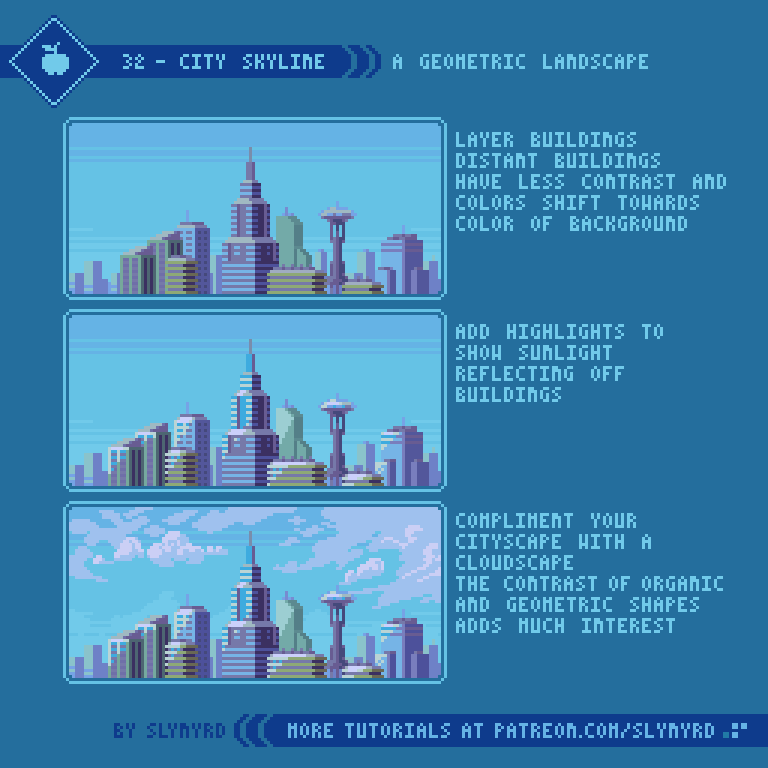Intro
Crowded, dirty, and sparse in nature, big cities certainly present some ugly realities. Yet, within the chaos that arises from massive populations, great beauty can be found. The convergence of people leads to marvelous human achievements, most notably displayed in the lofty structures that rise from the population. Viewed from a distance, where one can take in the totality of our modern marvels, the aesthetic shines the most. When I used to live in Japan, I loved going to observatory decks to gaze out across seemingly endless city. Nearing dusk, golden sunlight would reflect off the rooftops, creating a sea of metal and glass. As the sun set somewhere beyond Mt. Fuji, rivers of neon came to life and flowed across the landscape. Turns out the city really can be beautiful, even for this country boy.
SkyScrapers
The 3/4 side view is one of my favorite ways to draw architecture. In this projection the object appears skewed about 45 degrees away from a direct front facing view, foreshortening the sides to about 3/4 their actual width. This is simple to execute and always creates a convincing sense of depth when done with good color choice. I usually imagine the light source from the top left or right side of the scene, which results in a strong contrast in color between the two sides of the building, maximizing the feeling of depth.
Futuristic Skyscraper
Nowadays, many sky scrapers around the world have much more futuristic designs than what I’ve presented so far. My geometric designs are often more conservative than what is possible in real life. However, the geometry is well-suited for pixel art and result in a fine aesthetic.
You can see my approach to architecture is more like construction than drawing. Using simple geometry and few but precise angles, unlimited forms can be made. This constructive technique works well with all types of angular forms not limited to urban architecture. For example, you can spot some of the same forms in my airships, and various mechanical designs. This approach can even provide the base forms for some natural subjects, like rocks and cliffs. However, in those cases I break up the straight lines with more variation and add texture to give a more organic quality.
More futuristic city building on display in Pixelcast 30. Here I use a uniform color scheme across all the buildings. This makes the city feel like one cohesive mega structure, and enhances the concept of a strict ordered empire. Looks mighty, but maybe not such a fun place to live.
City Skyline
Now let’s put together some of the buildings we’ve learned to create into a larger city landscape.
Some cities are very dense and present a mountainous skyline of buildings overlapping into the distance, while others are more spaced out with just a few iconic structures standing above the blocky mass of the city. Organize your city however you see fit. I like to create each building as a separate layer so I have the freedom to move things around at any time to find the perfect composition. It’s also smart to duplicate some buildings and make small variations, rather than pixel each building from the ground up.
Once you are happy with the arrangement of the buildings, contextualize the scene with a background design. While I often save background details for last, I determine the light direction and general setting from the outset. Is it daytime, evening, or night? Is your city floating in space or submerged under the sea? For me, you can never go wrong with a nice cloudscape. The contrasting organic forms compliments the angles of the city and seems to balance out the scene.
FINAL THOUGHTS
Growing up in a modestly small city where the tallest building is about 6 or 7 stories, I often romanticized the city when I was younger. The giant buildings seemed so futuristic to me. After moving and living in the city for several years my romance faded, but something that never faded is my love for architecture and the way skyscrapers inspire me. The contrast between nature and monolithic structures made by humans deeply fascinates me. However, it is my hope that some day we can evolve our architecture to fit in with nature more harmoniously.
RESOURCES
Was this article helpful? If you find value in my content please consider becoming a Patreon member. Among many other rewards, Pixel Insider members get extra resources to compliment my tutorials. But most importantly, you allow me to continue making new content.
Assets featured in this Pixelblog are available in Cityscapes Assets Pack
Get caught up on all my downloads
If you're not ready to commit to the subscription model of Patreon, make a one-time donation and receive exclusive art and resources. Fan support is necessary to keep producing content. Thank you!
-By Raymond Schlitter





